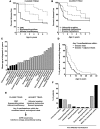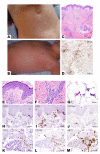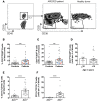Redefined clinical features and diagnostic criteria in autoimmune polyendocrinopathy-candidiasis-ectodermal dystrophy
- PMID: 27588307
- PMCID: PMC5004733
- DOI: 10.1172/jci.insight.88782
Redefined clinical features and diagnostic criteria in autoimmune polyendocrinopathy-candidiasis-ectodermal dystrophy
Abstract
Autoimmune polyendocrinopathy-candidiasis-ectodermal dystrophy (APECED) is a rare primary immunodeficiency disorder typically caused by homozygous AIRE mutations. It classically presents with chronic mucocutaneous candidiasis and autoimmunity that primarily targets endocrine tissues; hypoparathyroidism and adrenal insufficiency are most common. Developing any two of these classic triad manifestations establishes the diagnosis. Although widely recognized in Europe, where nonendocrine autoimmune manifestations are uncommon, APECED is less defined in patients from the Western Hemisphere. We enrolled 35 consecutive American APECED patients (33 from the US) in a prospective observational natural history study and systematically examined their genetic, clinical, autoantibody, and immunological characteristics. Most patients were compound heterozygous; the most common AIRE mutation was c.967_979del13. All but one patient had anti-IFN-ω autoantibodies, including 4 of 5 patients without biallelic AIRE mutations. Urticarial eruption, hepatitis, gastritis, intestinal dysfunction, pneumonitis, and Sjögren's-like syndrome, uncommon entities in European APECED cohorts, affected 40%-80% of American cases. Development of a classic diagnostic dyad was delayed at mean 7.38 years. Eighty percent of patients developed a median of 3 non-triad manifestations before a diagnostic dyad. Only 20% of patients had their first two manifestations among the classic triad. Urticarial eruption, intestinal dysfunction, and enamel hypoplasia were prominent among early manifestations. Patients exhibited expanded peripheral CD4+ T cells and CD21loCD38lo B lymphocytes. In summary, American APECED patients develop a diverse syndrome, with dramatic enrichment in organ-specific nonendocrine manifestations starting early in life, compared with European patients. Incorporation of these new manifestations into American diagnostic criteria would accelerate diagnosis by approximately 4 years and potentially prevent life-threatening endocrine complications.
Conflict of interest statement
The authors have declared that no conflict of interest exists.
Figures




References
-
- Cetani F, et al. A novel mutation of the autoimmune regulator gene in an Italian kindred with autoimmune polyendocrinopathy-candidiasis-ectodermal dystrophy, acting in a dominant fashion and strongly cosegregating with hypothyroid autoimmune thyroiditis. J Clin Endocrinol Metab. 2001;86(10):4747–4752. doi: 10.1210/jcem.86.10.7884. - DOI - PubMed
Grants and funding
LinkOut - more resources
Full Text Sources
Other Literature Sources
Medical
Research Materials

